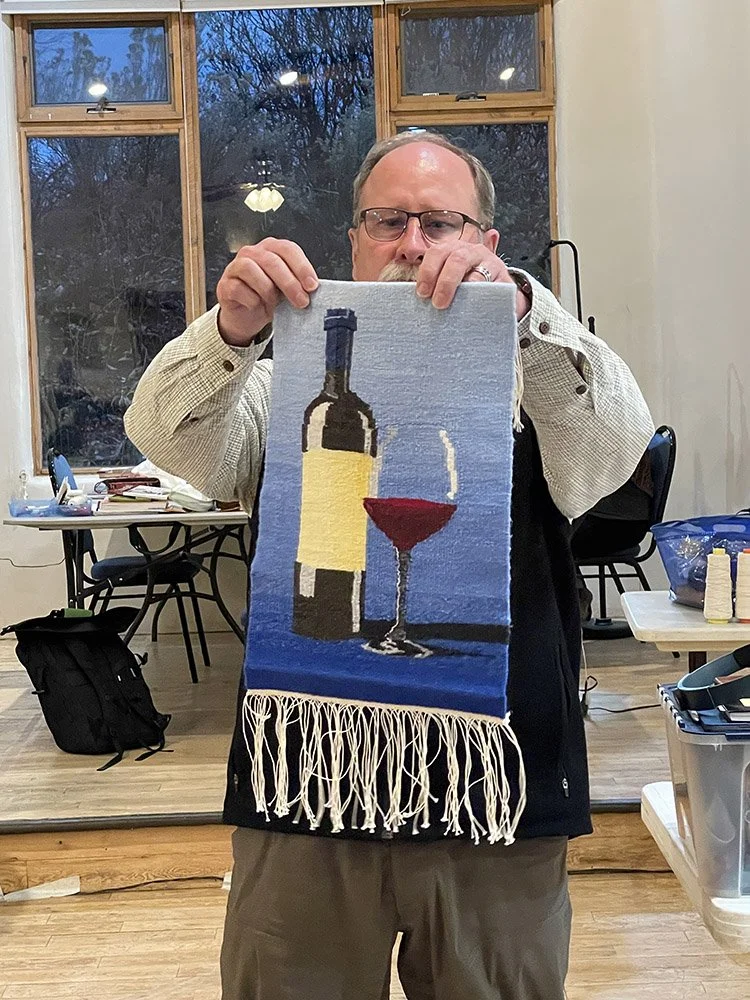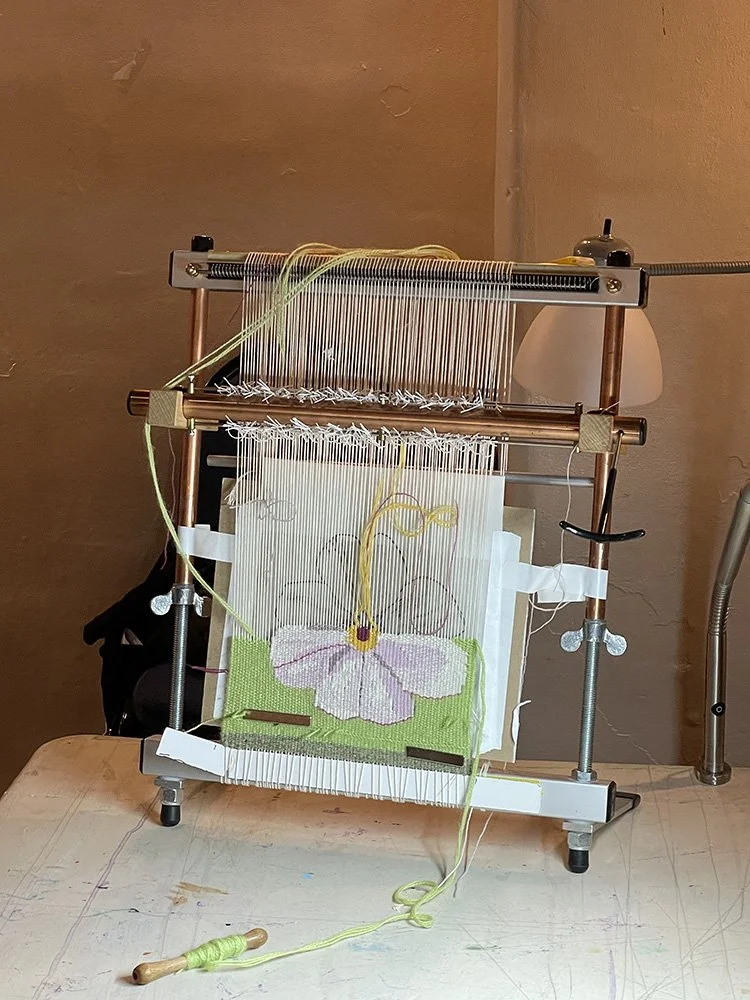Mabel Dodge Luhan House in Taos, NM
The week before last I was back in Taos teaching at Mabel Dodge Luhan House. We had a lovely week of tapestry weaving with a group of alumni, most of whom come back every year.
This retreat focuses on the design questions of the participants. This year I added another component and some of us looked at how to make vertical forms or lines in tapestry. Some of the participants used these ideas in their tapestries or samples for tapestries.
Making vertical forms in tapestry weaving is a challenge because we’re working on a grid and all vertically-oriented shapes have to go against that grid to build upward. That means that tapestry has a very stepped appearance. This is the nature of this art form and in a lot of cases I encourage students to embrace that.
But most of the time we want to make a stable textile and so all the regular factors of technique and materials come into play when weaving vertically oriented forms. During the retreat we talked about using techniques like double weft interlock, various other joins, sewing slits, using slits to suggest vertical lines, and other means of making marks that read as vertical lines.
The other challenge I was discussing was making curved forms read as curved even though they are full of steps. This is a challenge that could be an entire workshop on its own, and in fact I took such a workshop from Sarah Swett many years ago now. It was an ATA retreat and we spent the whole workshop weaving vertically oriented curves. It takes a lot of practice to get your eye to see how the curve has to happen and every time you change sett or materials, the calculus changes. Practice practice practice! (My blog post from that week in 2015 is HERE.)
Below are some photos from the week in Taos.
Taos was warm this year and we had some rain. From left to right: Kathy, Rebecca, Karen A., Lisa, Kevynne, Sue, Karen M., Victoria, Barb, Patricia, Jon, and Ercil.
Mabel Dodge Luhan House is a fascinating place to stay. The more times I return, the more history I learn and the more of Mabel’s books I read. She gathered artists around her in the mid-20th century and was a part of Taos becoming the artist community that it is. The house is adobe and more than 100 years old now. The doorways are often tight and low and there is one stairway that you have to crouch to get up and down.
The workshop rooms are large and cozy with heated floors. We always have nice periods of focus and weaving and then time to eat, socialize, or visit our favorite places in Taos.
The 2023 Taos retreat participants working away in the Juniper House workshop room.
The rest of the group weaving in the window in the Juniper House classroom.
Here is some yarn eye candy for you. Karen A. uses weaversbazaar for her large format tapestries and she brought all the colors to the retreat. I liked her method of organizing them so she can see all the colors and then pull out the ones she wants to use. This would also be a potential solution for those of you who have been asking how to organize Gist Array cones which are the same size as these.
Karen’s weaversbazaar stash organized so she can see all the colors at a glance.
We took an afternoon trip to Taos Wools which is just up the road in Arroyo Seco. We had a fantastic time meeting Soos, the new shop puppy, exploring all the beautiful tapestries and looms, and buying plenty of Joe’s hand-dyed yarn.
Taos Wools in Arroyo Seco is a yarn shop, gallery, and teaching studio.
Taos Wools has a new shop dog. Soos is 10 weeks old and already learning a lot about being a wool hound! He takes his job very seriously already and greeted everyone as they arrived.
Soos giving Ercil welcome kisses
Soos the shop puppy at Taos Wools
Soos and Sue who is a veterinarian got along famously.
I’d like to emphasize the fact that Joe Barry hand-dyes the yarn he sells. He has moved his dyeing operation to the shop, so if you go visit you can see him at work. It is a tremendous amount of work to hand-dye yarn and this is the only place I know of besides Tierra Wools where you can purchase hand-dyed wool from a website. It is beautiful stuff!
Joe Barry who owns Taos Wools dyeing some yarn for tapestry, weaving, or knitting.
Hand-dyed skeins drying on the fence. Taos Wools.
Mabel’s house was called Los Gallos. And there are definitely chickens there. Some stay there and some came along for the ride.
The gallery below has more photos from the week. Click to enlarge, arrows to scroll, hover for captions. If you’re reading this in email form, you can find the post on the web HERE.
If you can’t make it to a tapestry retreat with me, you can visit Mabel’s house as a bed and breakfast visitor. They hold all rooms for their workshops until a month ahead of time, so if they don’t have an opening when you want to go and it is more than a month out, try again closer to the date. The experience is well worth it any time of year. Mabel Dodge Luhan House.
Mabel’s house after dark
I drove home through a snow storm. Highway 64 to Chama was still open but I bet it will be closed soon!
Taos is clearly a favorite place for me. Though we didn’t end up moving there, we are now a lot closer and I will continue to teach there frequently. Join me sometime!
I’m finalizing a nice line-up of retreats for 2024 and they’re posted on my retreat and workshop pages so you can start planning! The January 2024 spinning for tapestry retreat in Taos with Jillian Moreno is full but I do have a waiting list if you’re interested.






















